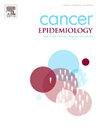1990-2021年全球女性乳腺癌发病率和死亡率时空动态变化趋势
IF 2.3
3区 医学
Q3 ONCOLOGY
引用次数: 0
摘要
背景:乳腺癌是影响女性最常见的恶性肿瘤,其发病率和死亡率存在显著的时空差异,因此探讨其动态趋势和聚类模式具有重要意义。方法:数据来自2021年全球疾病负担研究。本研究采用多种空间分析方法,系统考察了全球女性乳腺癌发病率和死亡率的时空分布格局。使用标准差椭圆法跟踪平均中心的变化和方向趋势,突出空间分布随时间的变化。在此基础上,空间自相关分析测量了整体空间聚类程度以及国家层面的局部聚类格局。为了进一步捕捉时空动态,时空扫描统计应用于检测跨越空间和时间的统计显著聚类区域。结果:1990-2021年,全球年龄标准化发病率(ASIR)和年龄标准化死亡率(ASDR)在2019年达到峰值,然后略有下降,然后再次上升。ASIR和ASDR的空间平均中心均呈现明显的东南移,其中ASIR的分布收缩,ASDR的分布保持稳定,且所有椭圆的东西向趋势一致。观察到持续的正空间自相关(Moran’s I: ASIR 0.28-0.39;正如0.40 - -0.45;p 结论:该研究揭示了全球女性乳腺癌的时空动态,强调了医疗资源、筛查和卫生政策的差异。本文章由计算机程序翻译,如有差异,请以英文原文为准。
Space-time dynamic variation trend of female breast cancer incidence and mortality: A global perspective (1990–2021)
Background
Breast cancer is the most common malignant tumor affecting women, with significant space-time disparities in incidence and mortality, underscoring the importance of exploring its dynamic trends and clustering patterns.
Methods
The data were obtained from the Global Burden of Disease Study 2021. The study employed multiple spatial analytical methods to systematically examine the space-time distribution patterns of female breast cancer incidence and mortality worldwide. The Standard Deviational Ellipse method was used to track shifts in mean centers and directional trends, highlighting changes in spatial distribution over time. Building on this, spatial autocorrelation analysis measured the degree of overall spatial clustering as well as local cluster patterns at the national level. To further capture the space-time dynamics, Space-Time Scan Statistics was applied to detect statistically significant clustering regions across both space and time.
Results
From 1990–2021, global age-standardized incidence rate (ASIR) and age-standardized death rate (ASDR) peaked in 2019, then slightly declined before rising again. The spatial mean centers of ASIR and ASDR exhibited notable southeastward shifts, with ASIR's distribution contracting while ASDR remained stable, and the east-west directional trend of all ellipses was consistent. Persistent positive spatial autocorrelation was observed (Moran’s I: ASIR 0.28–0.39; ASDR 0.40–0.45; p < 0.001). Local spatial autocorrelation analysis revealed that in 1990 and 2021, ASIR and ASDR exhibited significant spatial clustering characteristics in specific regions, particularly in Europe and Africa. High space-time clusters included ASIR centered in the UK (2015–2019, log likelihood ratio (LLR) = 735,045.42, relative risk (RR) = 2.72) and ASDR in Denmark (2015–2019, LLR = 207,088.37, RR = 2.55).
Conclusion
The study revealed the global space-time dynamics of female breast cancer, emphasizing disparities in medical resources, screening, and health policies.
求助全文
通过发布文献求助,成功后即可免费获取论文全文。
去求助
来源期刊

Cancer Epidemiology
医学-肿瘤学
CiteScore
4.50
自引率
3.80%
发文量
200
审稿时长
39 days
期刊介绍:
Cancer Epidemiology is dedicated to increasing understanding about cancer causes, prevention and control. The scope of the journal embraces all aspects of cancer epidemiology including:
• Descriptive epidemiology
• Studies of risk factors for disease initiation, development and prognosis
• Screening and early detection
• Prevention and control
• Methodological issues
The journal publishes original research articles (full length and short reports), systematic reviews and meta-analyses, editorials, commentaries and letters to the editor commenting on previously published research.
 求助内容:
求助内容: 应助结果提醒方式:
应助结果提醒方式:


